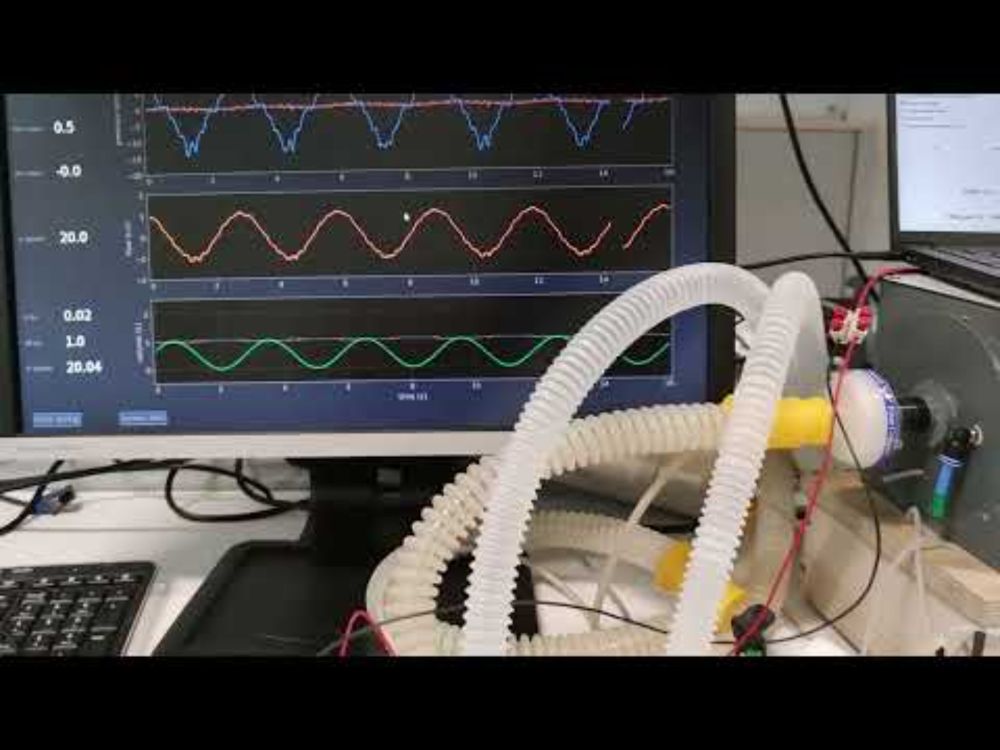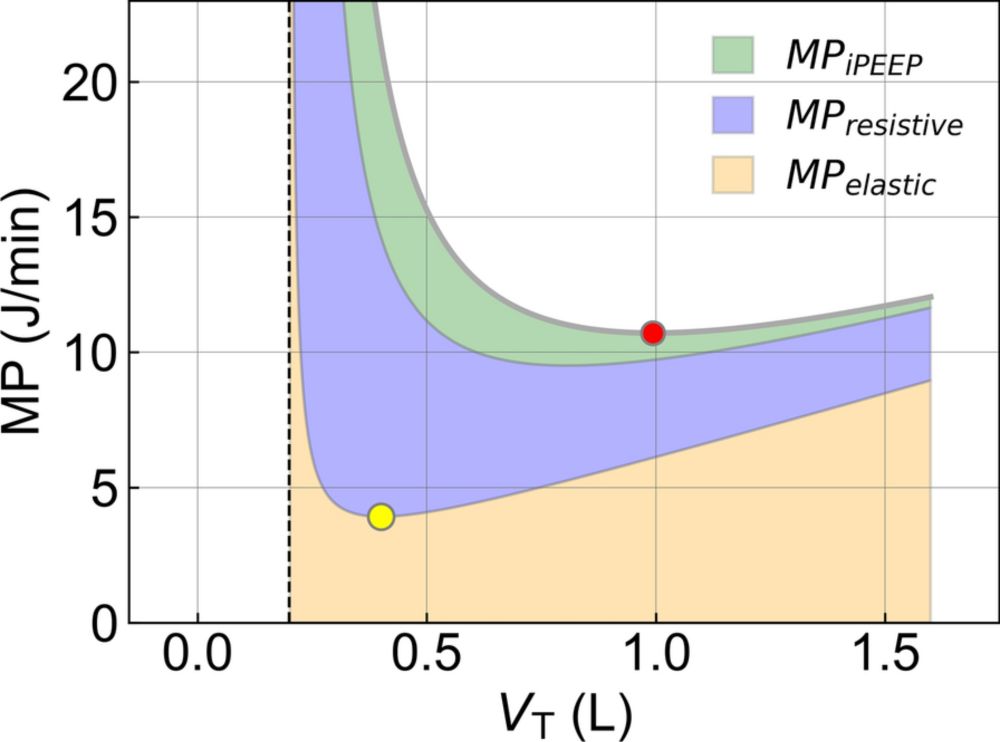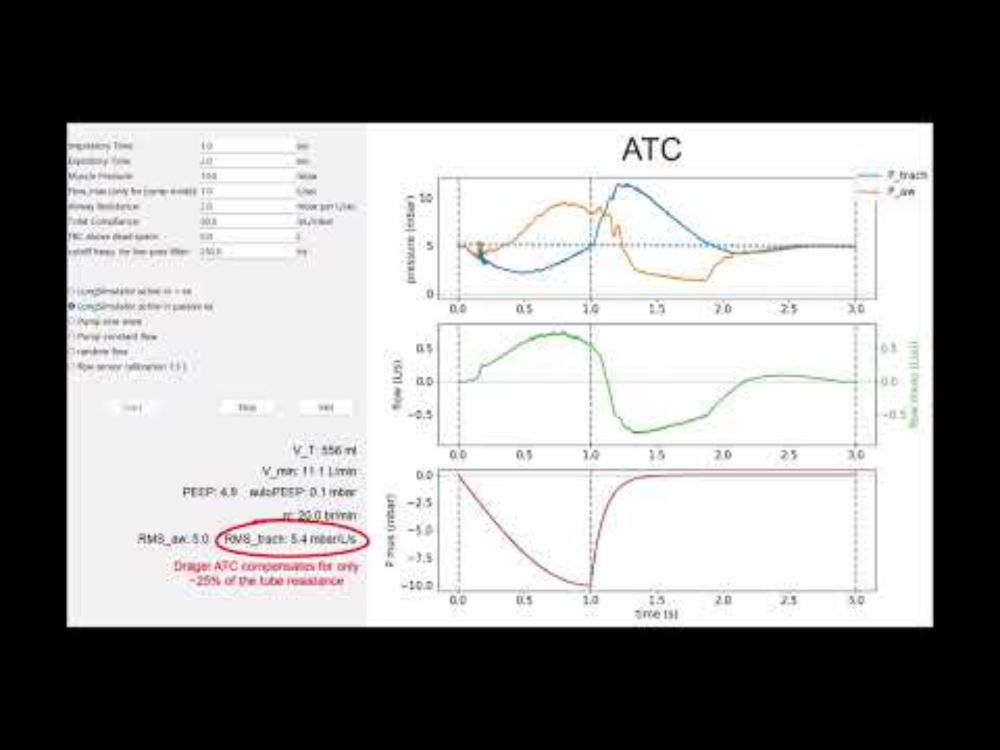Thank you for your kind words! I think it's a great teaching tool, but realistically, I don't see it being integrated into routine clinical practice, even though patients would benefit from it.
02.09.2025 11:37 — 👍 1 🔁 0 💬 0 📌 0
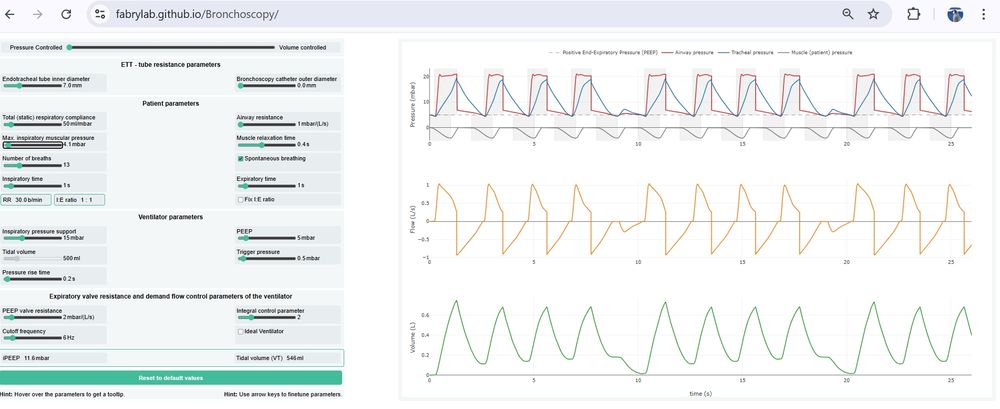
We developed a browser-based tool to predict ventilation impairments such as iPEEP buildup, hypoventilation, and desynchronization due to the tube resistance (also during bronchoscopy). Check it out: fabrylab.github.io/Bronchoscopy/
13.05.2025 08:41 — 👍 1 🔁 0 💬 1 📌 0
Drop me a line if you are interested in this new technology. Also, if you a manufacturer of ventilators, I would love to test one of your ventilators in my lab, if you are willing to loan me one for one or two weeks.
15.01.2025 18:08 — 👍 0 🔁 0 💬 0 📌 0
Commercial ventilators often (perhaps all of them?) suffer from sluggish demand-flow delivery and cannot exploit the full potential of ATC. I have therefore developed a new ventilator featuring a fast and precise demand flow controller to deliver proper ATC.
15.01.2025 18:08 — 👍 0 🔁 0 💬 1 📌 0
Unfortunately, current pressure support modes cannot deal with weak patients with rapid shallow breathing, or with large inspiratory efforts. The solution to this problem is proper Automatic Tube Compensation (ATC), if needed in combination with proportional assist ventilation (PAV).
15.01.2025 18:08 — 👍 0 🔁 0 💬 1 📌 0
Empowering patients to breathe spontaneously as early as possible, and only support the work of breathing the patient cannot produce on their own, is the best way to reduce the pressure load on the lungs, and to avoid VILI.
15.01.2025 18:08 — 👍 2 🔁 0 💬 1 📌 0
YouTube video by lpmtvideo
Comparison ATC-mode Dräger V600 vs self-made ATC ventilator
How does a commercial ventilator (Dräger V600) in ATC mode compare to my 3D printed ATC ventilator? Poorly, I would say, but judge for yourself. I am convinced that weaning can be greatly improved and shortened with real ATC. youtu.be/Y4To7-krE14
20.12.2024 16:02 — 👍 0 🔁 0 💬 0 📌 0

Yesterday, with the retirement symposium of my academic mentor Jeff Fredberg, the era of respiratory physiology research at the Harvard School of Public Health that began with Jim Whittenberger in 1948 came to an end.
15.12.2024 14:37 — 👍 0 🔁 0 💬 0 📌 0
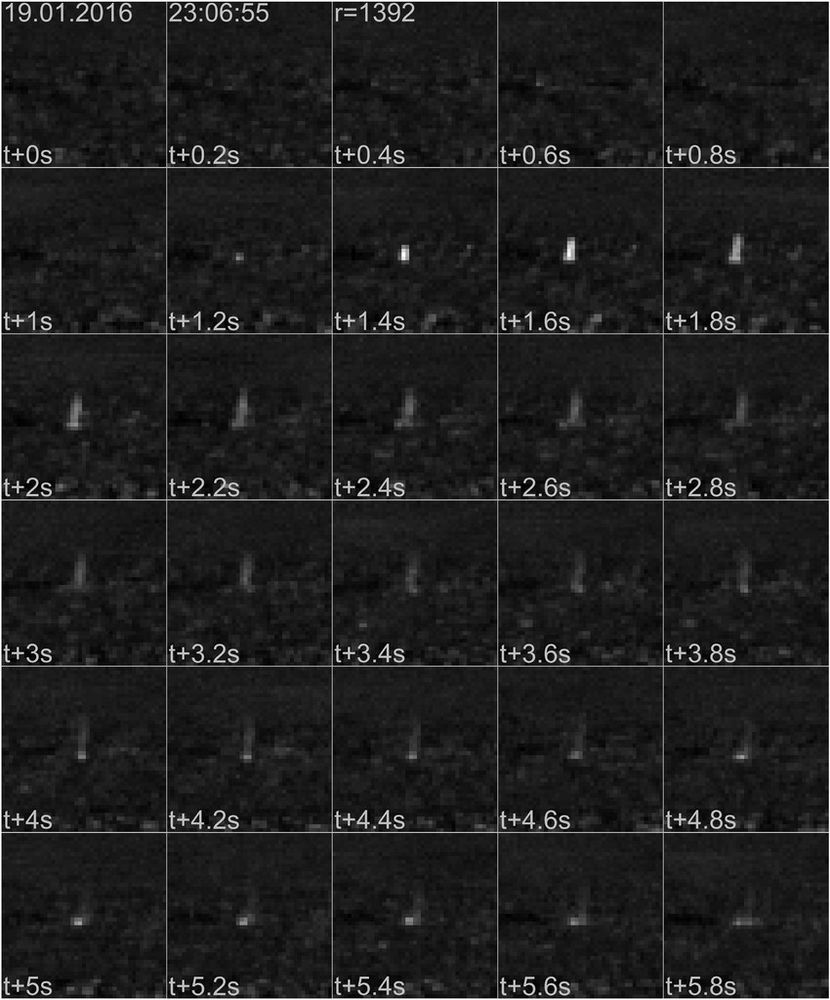
.. and just in case you are wondering what whale research has to do with respiratory physiology - have you ever seen a whale blow? We develop thermal imaging systems that pick up the thermal signature of whale blows to study whale ecology. doi.org/10.1175/JTEC...
10.12.2024 12:29 — 👍 0 🔁 1 💬 0 📌 0

The #FREEPAULWATSON petition
On July 21 2024, Captain Paul Watson was arrested by Danish police upon arrival in Nuuk, Greenland, onboard the M/Y John Paul DeJoria. We need your help to #FREEPAULWATSON.
Few of you know that my lab is also active in whale research. That's why I’m urging you to sign the petition to free anti-whaling activist Paul Watson. Denmark may extradite him to Japan, where he faces a 15-year prison sentence. www.paulwatsonfoundation.org/freepaulwats...
10.12.2024 12:13 — 👍 1 🔁 1 💬 1 📌 0
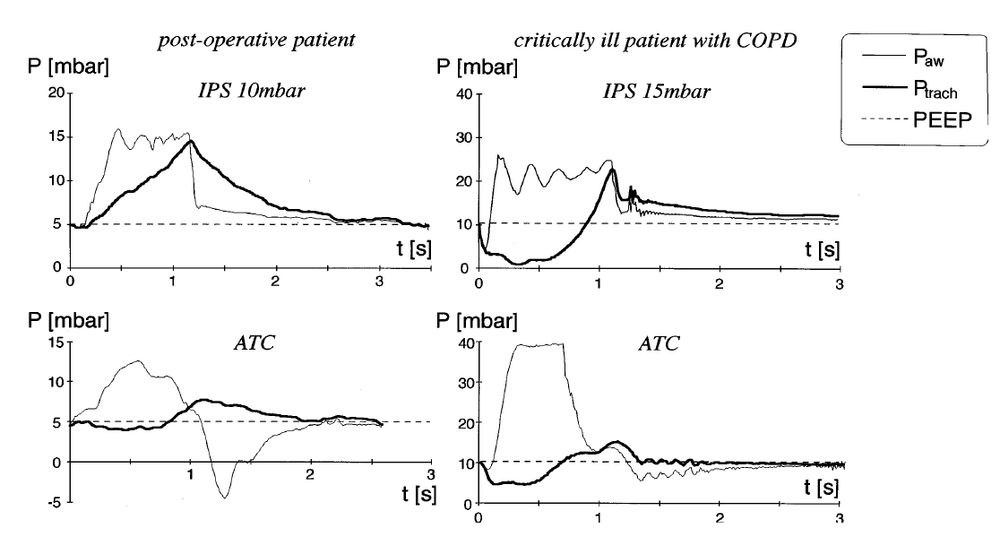
Not sure I understand the question. Perhaps this: A pressure support of 15 mbar is adequate for "normal" patients, but not for those with higher resp. drive (Vmin > 10 L/min). doi.org/10.1007/s001...
10.12.2024 09:08 — 👍 0 🔁 0 💬 0 📌 0
I visited a cardiac ICU almost every day for 5 years and never saw a case of VILI. Of course, you don't want to overinflate the healthy lungs of cardiac patients, but that's mainly for hemodynamic reasons.
10.12.2024 09:02 — 👍 0 🔁 0 💬 0 📌 0
Paw is irrelevant as Ptrach will still remain at PEEP at all times. The patient can freely breathe as if extubated, and is free to choose a small or large tidal volume, like you and me.
08.12.2024 14:55 — 👍 0 🔁 0 💬 0 📌 0
Yes, during a vigorous inspiratory effort, Paw can rise to >35 mbar above PEEP, but that does not cause VILI, rather, it prevents Ptrach and Palv to become negative and hence prevents PSILI.
08.12.2024 13:45 — 👍 0 🔁 0 💬 1 📌 0
You mean you are afraid that Paw drops below PEEP during expiration? Don't be. Ptrach will still remain at around PEEP. And also consider that proper ATC, unlike CPAP or PSV, prevents Ptrach to become negative during inspiration.
08.12.2024 12:59 — 👍 0 🔁 0 💬 1 📌 0
Could not agree more.
07.12.2024 07:45 — 👍 0 🔁 0 💬 0 📌 0
YouTube video by lpmtvideo
Dräger Evita V600 in CPAP and ATC mode
Today, I tested the Dräger Evita V600 ventilator in CPAP and ATC mode with a lung simulator. CPAP worked well, but in ATC mode, the V600 compensates only ~25% of the total tube resistance, and that is possibly not enough to make a difference for patients. youtu.be/AcRkQqnk-gg
06.12.2024 18:55 — 👍 11 🔁 1 💬 2 📌 1
I imported my Twitter posts using Porto (Chrome extension) to add some content. Sorry for cluttering up your timeline. I also have to say that Porto did not work so well, it ignored most of my tweets, for no reason.
05.12.2024 20:19 — 👍 0 🔁 0 💬 0 📌 0
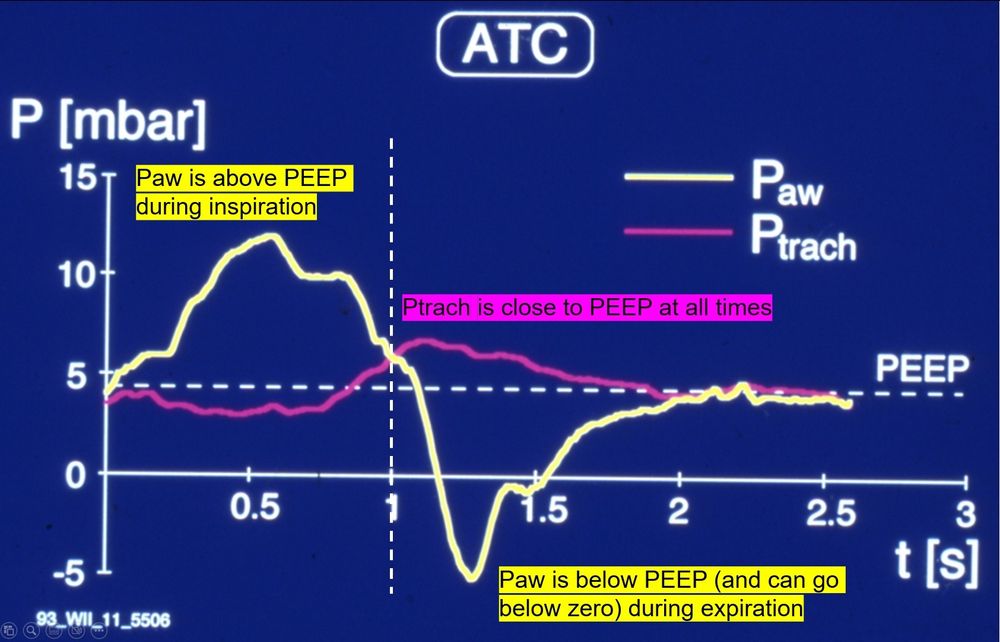
I used to be on Twitter (@ATC_Ventilator) and now join Bluesky; my aim is to discuss topics around the mode Automatic Tube Compensation, weaning, lung physiology and mechanical ventilation with intensivists.
15.11.2024 14:28 — 👍 3 🔁 2 💬 1 📌 0
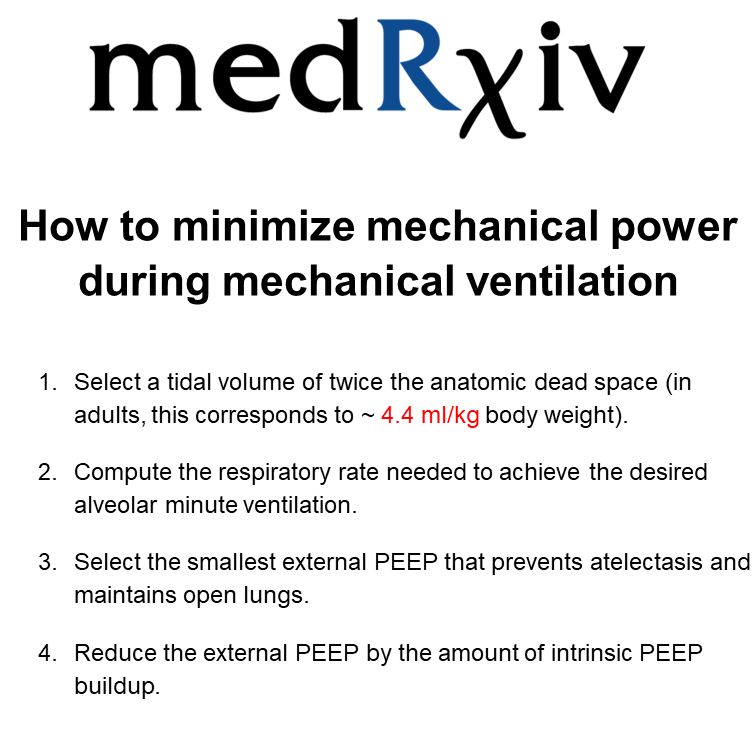
New on medRxiv! “How to minimize mechanical power during mechanical ventilation”
For any given V'min, a tidal volume of twice the anatomic dead space (~4.4 ml/kg in adults) always minimizes elastic mechanical power (the energy needed for lung expansion).
medrxiv.org/content/10.110…
06.11.2024 16:54 — 👍 0 🔁 0 💬 0 📌 0
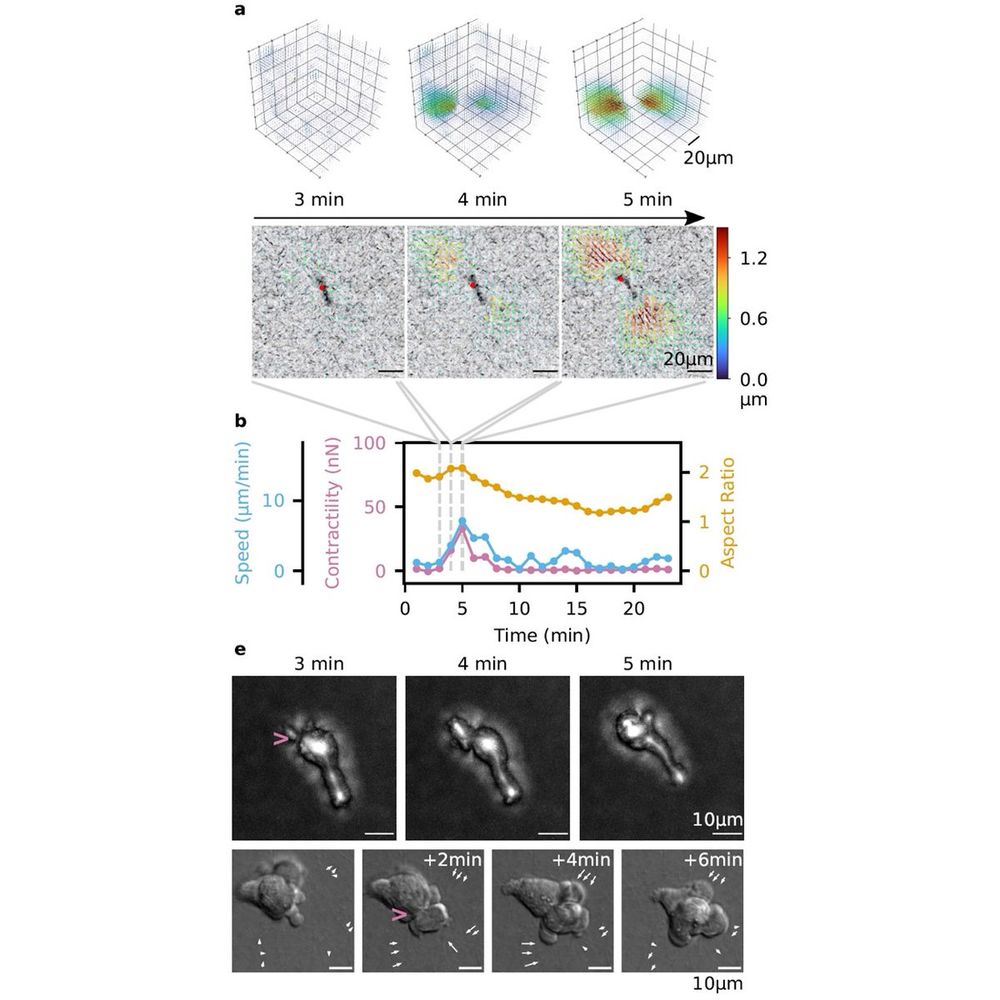
The inflamed lung is full of immune cells, but how do they get there? We found that immune cells can generate large traction forces - comparable to fibroblasts - that help them migrate through narrow pores. Read more in Nature Physics:
rdcu.be/dU9Nj
27.09.2024 16:02 — 👍 0 🔁 0 💬 0 📌 0
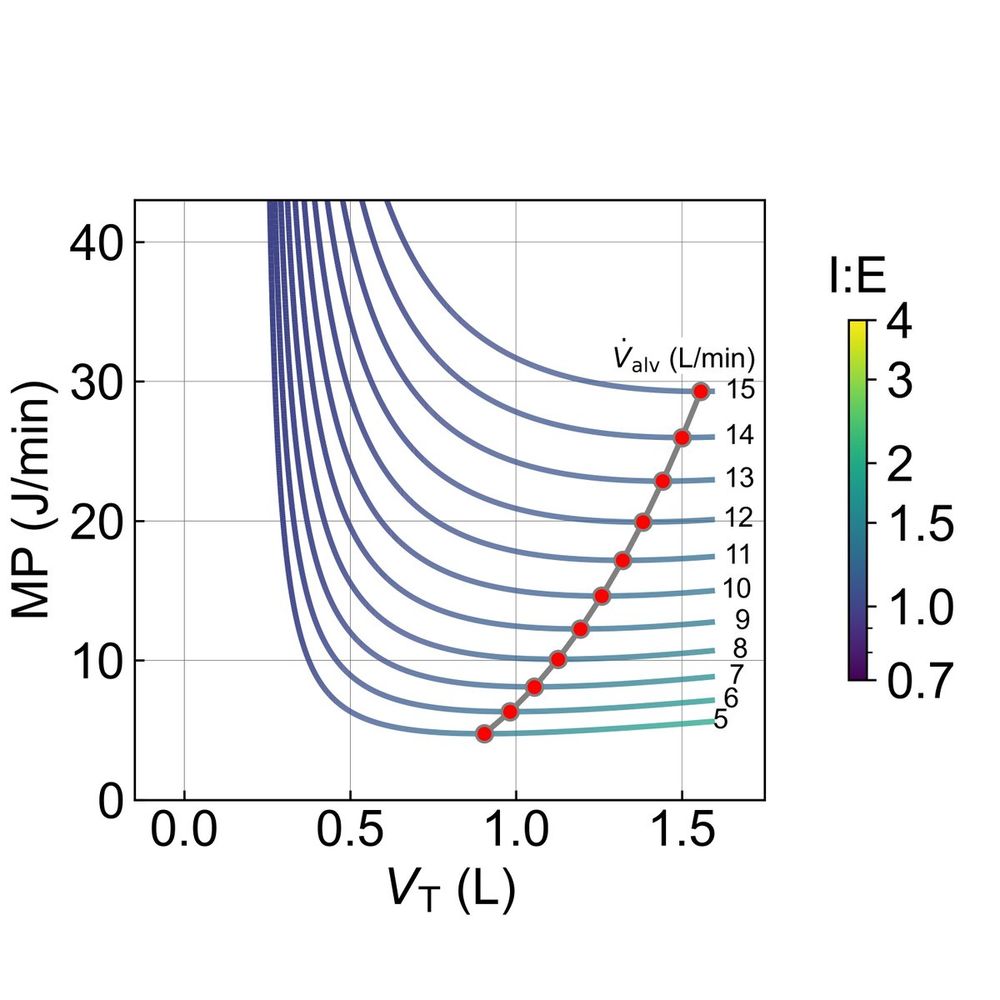
Minimization of Mechanical Power happens at high tidal volumes beyond what is lung-protective. But why? One reason is the resistive work, which decreases at larger tidal volumes. This resistive power is dominated by the resistance of the endotracheal tube.
30.08.2024 14:47 — 👍 0 🔁 0 💬 0 📌 0
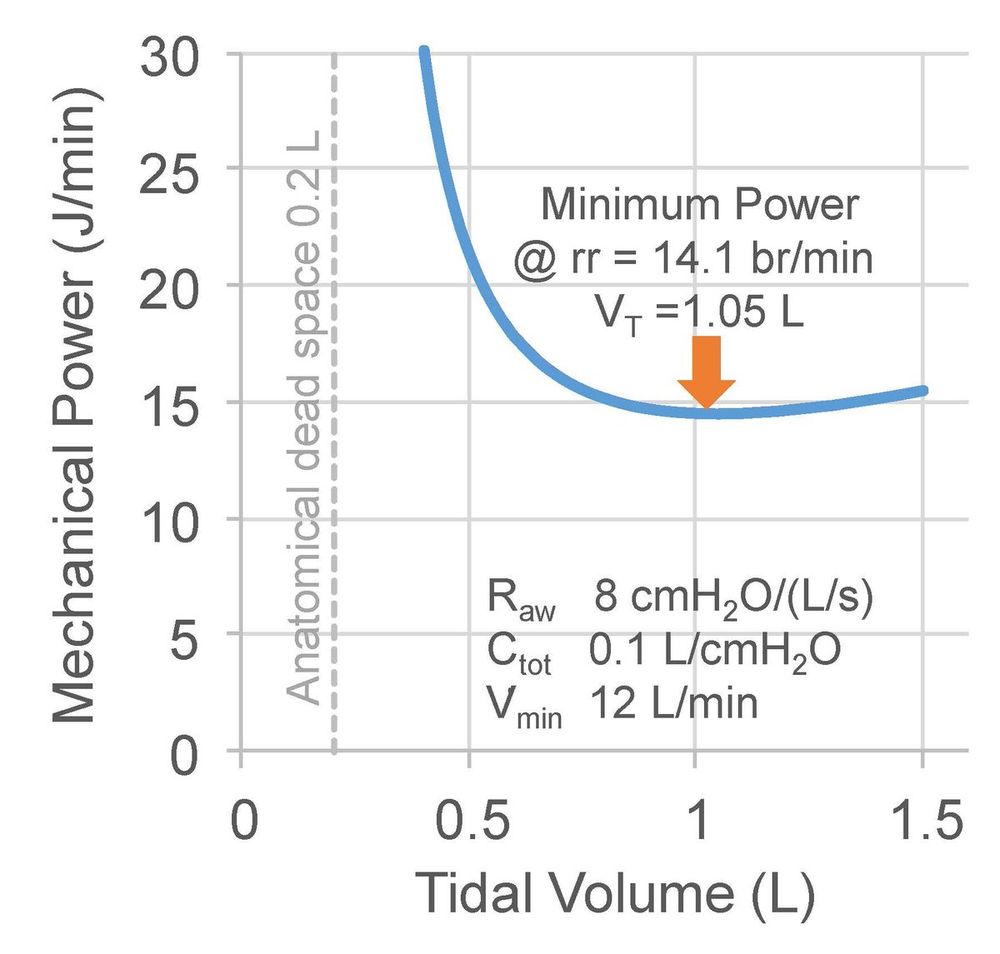
For a given alveolar minute ventilation, which combination of frequency and volume minimizes mechanical power according to the @Gattinon equation? This depends on lung parameters but may result in dangerously high tidal volumes. DO NOT try to minimize the mechanical power.
05.08.2024 10:29 — 👍 0 🔁 0 💬 0 📌 0
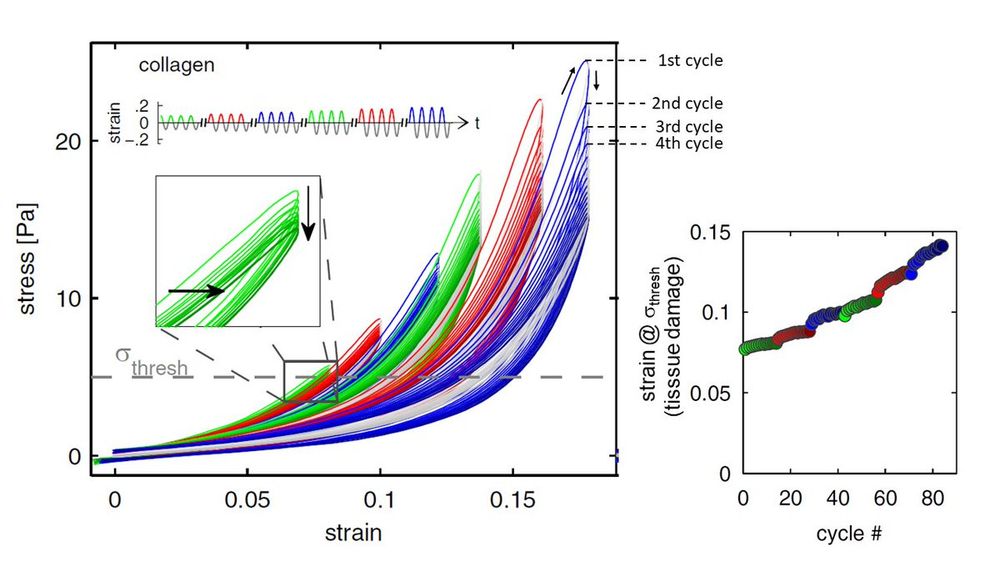
Excessive strain (e.g. due to a large tidal volume) causes tissue damage due to overdistension, but most of the damage occurs already in the first cycle. Subsequent cycles add smaller and smaller increments.@thomasanderson
@gattinon
bio.physik.fau.de/publications/M…
01.08.2024 07:24 — 👍 0 🔁 0 💬 0 📌 0
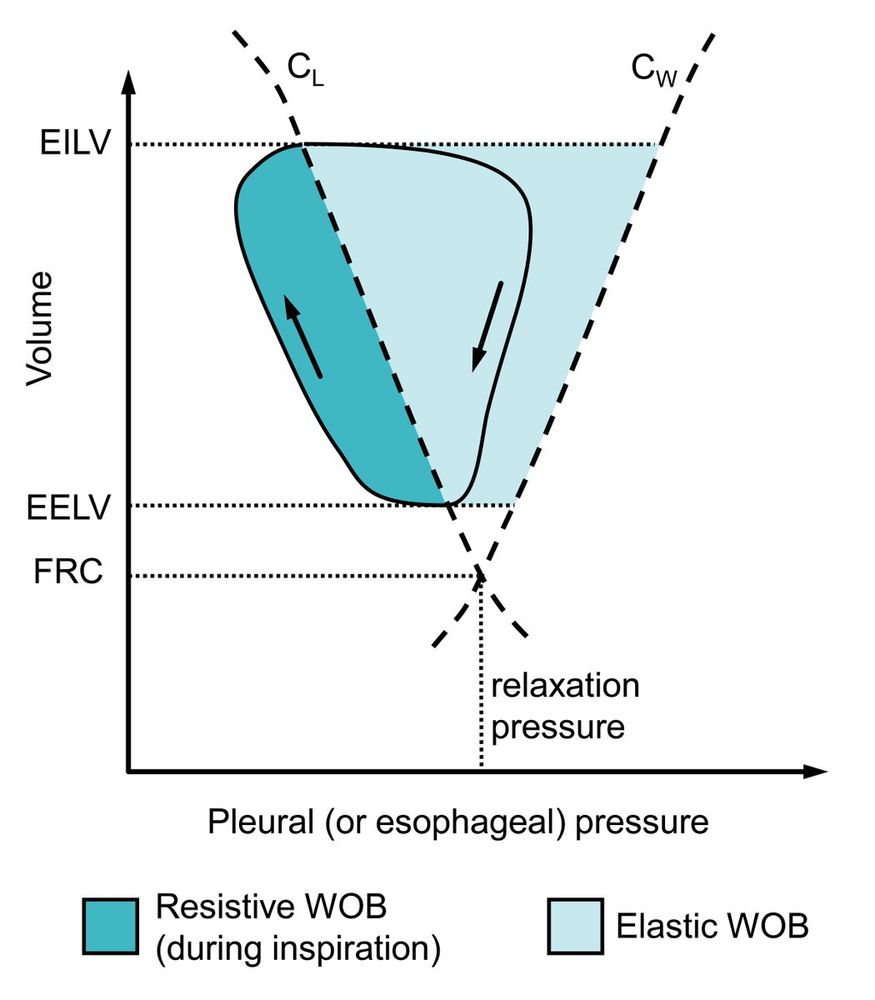
This is how the elastic work of breathing (WOB) is depicted in a Campbell diagram, which was misrepresented in a recent @ERSpublications on ventilatory muscle recruitment during exercise in patients with COPD and interstitial lung disease:
bit.ly/3HVrsuh
18.07.2024 18:56 — 👍 0 🔁 0 💬 0 📌 0
Lumping together PEEP, peak pressure, volume, and what have you into a half-baked formula for mechanical power obfuscates the real issues: stiff lungs, high pressure, regional lung tissue overdistension, and atelectrauma.
19.03.2024 23:08 — 👍 0 🔁 0 💬 0 📌 0
Editors: Josef Trapani & Peter Nydahl
Official Journal of the British Association of Critical Care Nurses
https://onlinelibrary.wiley.com/journal/14785153
Associate Editor, Intensive and Critical Care Nursing
Assistant Professor, School of Nursing, LKS Faculty of Medicine, The University of Hong Kong
https://hub.hku.hk/cris/rp/rp02925
Academic Cardiac and Mobile Anaesthetist | University of Melbourne and Medical School | Medical Director of Sleep Dentistry Services | Day Care Anaesthesia Special Interest Committee
🌐 www.sleepdentistryservices.com.au
📞 0429 058 878
Anesthesiologist. Love trying out new tech.
Scottish Intensive Care Society. Looking after people looking after people in ICU in Scotland.
Chief, Emergency Medicine, Department of Pediatrics, Duke School of Medicine
Medical Education. Anaesthesia. All views my own.
ICU specialist. Researcher in deteriorating patients and RRS.
Clinical Lead for Anaesthetics ESHT. Regional Anaesthesia enthusiast.
Football. Crystal Palace. FPL. Techno. Birds. Rye. Family. Not in any particular order.
Intensivist and prof. @Rigshospitalet, CPH, Denmark 🇩🇰
Collaboration for Research in Intensive Care www.cric.nu
Vicechair Danish Medical Societies
#6S #TRISS #CLASSIC #COVID_STEROID trials
#INCEPT Intensive Care Platform Trial www.incept.dk
Edinburgh Critical Care Research Group - A vibrant multidisciplinary research group within the University of Edinburgh.
https://usher.ed.ac.uk/anaesthesia/team-members/coordinators
Our News: https://usher.ed.ac.uk/anaesthesia/team-members
Researcher in critical care. Co-Director at Intensive Care National Audit & Research Centre.
Anaesthetist and Intensivist. Trauma addict. PHEM. Research. Austrian accent. Views are my own.
Critical care physician, physiologist. Executive editor NEJM Evidence, reviews editor New England Journal of Medicine. Opinions my own.
Formed in 1934, the Australian Society of Anaesthetists is a not-for-profit, member-funded organisation dedicated to supporting, representing and educating anaesthetists to ensure the safest possible anaesthesia for the community.
Intensivist @santiago_uci , PhD • Clinical Researcher @sicrus_research @idis_research • @ESICM NEXT Committee Chair 🇪🇺
Dr Rakesh Garg
Editor-in-Chief
Indian Journal of Anaesthesia (IJA),
Official PubMed indexed publication of Indian Society of Anaesthesiologists (ISA)
Impact Factor 2.9
Professor, All India Institute of Medical Sciences (AIIMS), New Delhi, India
Anesthesiologist & Intensive Care Specialist
Respiratory Therapist | #MechanicalVentilation | #Resuscitation | #Airway | #Education | #emimcc


